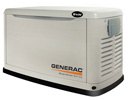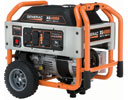THE BUSINESS PAGE
Stokewoods Diner
1001 Carl Broggi Hwy
Lebanon 207-457-6021
Sun., Mon. & Wed.
7 a.m. to 3 p.m.
Thursday thru Saturday
7 a.m. to 8 p.m
GENERATING SOME
INTEREST
posted 10:30 a.m., Saturday, Jan. 12
By Harrison Thorp
The Lebanon Voice
For as little as $750 plus installation a homeowner can feel a little less powerless against the vagaries of a northern New England winter.
So why don’t more folks from Lebanon and Milton take that power plunge and buy a generator that could make life so much easier when the winds blow and the lights go out?
Could it be our stubborn self-reliance that eschews such conveniences? Could it be money? Could it be worries over adapting our home’s electrical system to generator mode? Could it be maintenance of the generator.
In actuality, it could be a combination of all the above, but whatever it is, one thing is certain. Even with the effects of superstorm Sandy, which knocked out power to 8.5 million homes in mid-Atlantic and Northeast states, demand although steady, has spiked little, said Roger Tessier of Tessier Power Systems in Lebanon.
Which may be good, because if you wanted to get a generator for this winter, you would probably be out of luck. The typical delivery wait for a new Generac generator, the type that Tessier sells, is eight-10 weeks which means you wouldn’t get your generator until late March.
The money concerns, however, shouldn’t be as daunting as they used to be, said Tessier, who now offers financing for the generators he sells.
A generator primer
There are basically two types of generators: standbys and portables.
While one local generator dealer relates no huge spike since superstorm Sandy, homeowners' interest in providing a secure power package for their home is trending upward.
Standbys are the ones that start by themselves when your power goes out, run on propane and cost anywhere from $2,800-$8,200. The most popular model is about $4,000, including installation, Tessier said.
Portables are the ones that you typically pull a power cord to start, run on gasoline and start at around $750, plus installation.
If you do want a generator with enough wattage to power your whole house, experts say a 3,000-square-foot home with an electric range might require as much as 25 to 30 kilowatts. If you want a generator that can power everything in your house, just not all at the same time, you might just need 20 kilowatts.
Tessier said the more kilowatts, the more the generator costs, but usually the $4,000 standby system will handle pretty much all a typical homeowner's needs.
He also likes the standbys more because they’re fueled by propane, which you keep in a tank at your house, while the portables use gasoline, and gasoline pumps at service stations may be unworkable in the event of an area outage. In Sandy long lines at some gas stations sparked near-fistfights as frantic homeowners queued for gas to power home generators.
Lastly he said portables need much more attention and maintenance, adding they have to be started up regularly during periods of disuse, and that gasoline must be fully drained after each use to prevent it from going stale and turning into shellac.
For more information go to http://generac.com or http://tessierpowersystems.com.
A standby system, left, switches on automatically in the event of a power loss, must be permanently mounted and runs on propane, while a portable, below, costs less, must be started with a pull cord and is fueled by gasoline.
courtesy
photos
The Lebanon Voice: Lebanon and Milton's hometown paper
Home heating oil dealers,
customers warm to bioheat
posted 2:40 p.m., Thursday, Feb. 28
By Harrison Thorp
The Lebanon Voice
When Jim Proulx of Proulx Oil and Propane in Newmarket, N.H., was first introduced to bioheat, he smelled a winner.
Literally.
A friend was using a biodiesel mix in his truck and was explaining the product and told Proulx to smell the exhaust.
“It smelled like a drop of cooking oil on a hot frying pan,” Proulx said. “Now, you know what diesel smells like. Which (product) would you like to be around?”
Biodiesel is regular diesel fuel combined with a mixture of soybean oil, animal fat and yellow grease (also called restaurant grease). It has been around for about 10 years, says Paul Nazzaro, a petroleum adviser with the National Biodiesel Board based in North Andover, Mass.
He said the technology became available to integrate biodiesel with heating oil to make bioheat, which he says burns cleaner, is easier on oil burners and is greener than conventional heating oil.
He said it also helps the efficiency of heating systems and extends their life. For consumers, transition to bioheat is seemless, he added.
About eight years ago when Proulx first learned of bioheat, it was slightly more expensive, he said, but he was intrigued with the idea of a cleaner-burning fuel.
Then when a production credit was offered that brought the price slightly below regular home heating oil blend, “I became more enthusiastic,” he said. “I think we’re all in favor of the environment, so as a businessman here was a product that was as good or better, and yes there is a green component, and now it’s less expensive and better. I’m doing a disservice not to support it.”
Bioheat’s cost has since risen slightly, but Proulx sells a 4 percent bioheat blend in all his fuels and keeps his prices competitive.
“People like the fact that it’s cleaner and better for the environment,” he said this week.
Proulx said customers can boost their blend to between 9 and 10 for no extra charge, or go as high as the current threshold of 20 percent for about an extra dime a gallon.
Nazzaro said many oil dealers have been slow to get onboard with bioheat for many reasons, but mostly because, “their plates are full with survival mode.”
Rick Card, CEO of D.F. Richard Energy of Dover, said all of the oil retailers who pick up at the Newington plants have some bioheat component in their fuel, though many don’t even know it.
One Seacoast oil dealer told The Lebanon Voice he did not have any bioheat blends available.
Card said it is mandated by the federal government to have some bioheat blend and as much as 5 percent, though many home heating oil companies do not market it.
Card said D.F. Richard fuels carries a 5 percent bioheat mixture, but his company does not offer any higher percentage blends, though they may become available in the future.
D.F. Richard also injects an extra chemical additive called “greenburn” to its fuel to make burners run more efficiently and cleaner.
Another area dealer that offers a bioheat blend is Downeast Energy of Dover.
For more information about bioheat go to http://bioheatonline.com.



